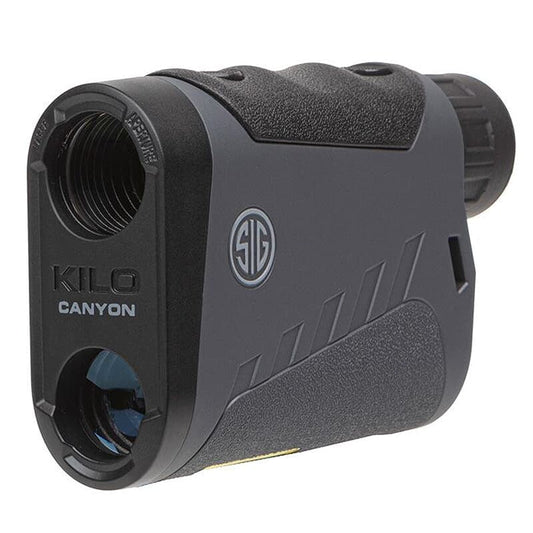

Sig Sauer Kilo Canyon Laser Rangefinding Monocular 6x22mm features a red LED illuminated display for clear visibility, even in low-light conditions. This monocular employs advanced Lightwave DSP Technology, providing lightning-fast range updates, allowing measurements of targets up to 3000 yards. The compact and lightweight design makes it an ideal companion for both hunting and shooting range activities, ensuring you have precise measurements at your fingertips.
With a HyperScan feature that delivers 4x updates per second, this model keeps pace with dynamic environments. The onboard ballistic calculator allows users to easily switch between MOA and MRAD outputs, catering to various shooting preferences. SpectraCoat™ anti-reflection coatings enhance light transmission and optical clarity, making this rangefinder a practical choice for outdoor enthusiasts.
Features:
- FAST RANGEFINDING for targets up to 3000 yards, ensuring you never miss a critical shot.
- ILLUMINATED DISPLAY for optimal visibility in low-light conditions, making it perfect for dawn or dusk.
- LIGHTWEIGHT DESIGN enhances portability, easily fitting into your pocket or pack.
- HYPERSCAN TECHNOLOGY delivers 4x updates per second, keeping you informed in dynamic situations.
- ANTI-REFLECTION COATINGS for superior clarity and light transmission, even in bright conditions.
- ADJUSTABLE EYECUP provides comfort for extended use, so you can stay focused longer.
- ONBOARD BALLISTIC CALCULATOR offers solutions in MOA or MRAD, adapting to your shooting style.
- DURABLE CONSTRUCTION ensures lasting performance in rugged environments.
Technical Specifications Table
| Specification | Details |
|---|---|
| Magnification | 6x |
| Lens Diameter | 22mm |
| Dimensions | 4.6" x 2.9" x 1.3" |
| Field of View | 6.5° |
| Weight | Lightweight Polymer |
| Ballistic Groups | 8 Onboard |
What’s in the Box?
- Sig Sauer Kilo Canyon Laser Rangefinding Monocular
- Lens cover
- Padded carrying case
- User manual
Customer Reviews
"Absolutely love the Kilo Canyon! The range is incredible and the display is super clear." - John D.
"Best budget rangefinder out there. It's lightweight and easy to use!" - Sarah P.
"The ballistic calculator is a game changer for precision shooting!" - Mike T.
FAQ
Q: How does the Kilo Canyon compare to other rangefinders?
The Kilo Canyon stands out with its rapid 4x updates per second, providing you with the fastest measurements compared to competitors. Its compact size doesn’t compromise on performance, making it ideal for both recreational and serious shooters.
Q: What should I do to maintain the Kilo Canyon?
To ensure longevity, clean the lenses with a microfiber cloth and store it in a protective case when not in use. Regular checks of the battery ensure optimal performance during outings.
Similar Models
Looking for more options for your outdoor adventures? Discover our extensive Sig Sauer lineup, including the Sig Sauer Kilo 2400BDX for extended range capabilities and the Sig Sauer Kilo 1000 for a more compact solution. Explore our full collection for exceptional optics tailored to your needs.
You May Also Like
Here’s some of our most similar products people are buying. Click to discover trending style.







